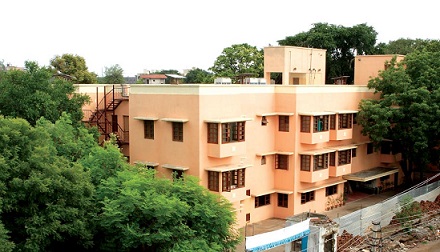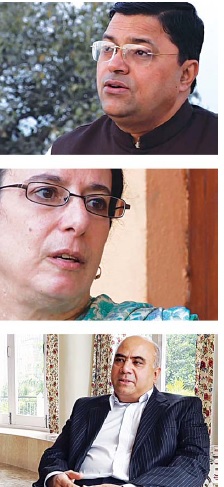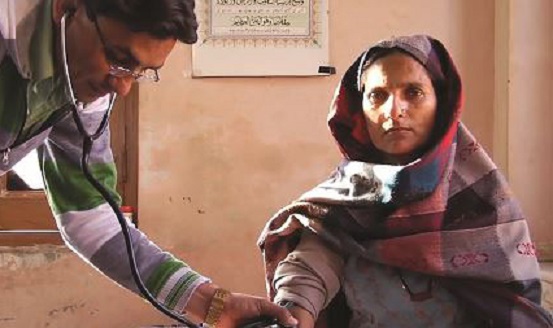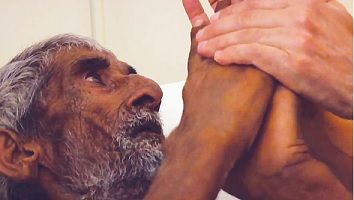
Shortly before passing away in Vrindavan, a devotee requested her spiritual master to establish a “Back to Godhead” clinic there for Srila Prabhupada’s followers
In his book Mathura Mahatmya, the great devotional scholar and acarya Srila Rupa Gosvami states, “They who die in the area of Mathura and Vrindavan become perfect and attain the supreme destination.” But most devotees do not reside in Vrindavan, and until recently, even those who had sufficient notice and facility would not find a proper support system to see them through their final stages once they arrived.
One devotee who was able to pass away in Vrindavan in the best way possible was Arca-vigraha Dasi. Born Aileen Lipkin, Arca-vigraha was a South African painter and sculptor of international repute. She joined ISKCON in Johannesburg in 1985 at the age of fifty-two and moved permanently to Vrindavan toward the end of 1991, when she was diagnosed with terminal cancer. According to her physician, she had only six months to live. She was already building a house in the Raman Reti area near ISKCON’s Krishna- Balaram Temple, and she soon moved and stayed there with a devoted godsister until she passed away two and a half years later. Throughout her increasingly painful illness, she lacked neither spiritual nor material care. As a spiritually advanced soul, she attracted the company of other elevated Vaisnavas, and many devotees were eager to have her association and to offer service.
Having experienced the benefits of preparing to pass away in Vrindavan, Arca-vigraha desired that other devotees should have the same opportunity, and shortly before her departure she requested her spiritual master, His Holiness Giriraja Swami, to establish a “Back to Godhead” clinic where dying devotees could spend their last days supported by loving devotees and expert caregivers.
Originally, Giriraja Swami wanted to get a large piece of land and build cottages so that each devotee would have his or her own place, as Arca-vigraha did. But when he and his team saw that getting enough land for an affordable price would take the hospice far from the Krishna-Balaram Temple, they decided to create the atmosphere of a home in a larger institutional setting. The team considered several plots, but when one after another the properties became unavailable, Abhirama Dasa – who had designed resorts in several countries and, in Vrindavan, both the MVT Guest House complex and the Kirtan Ashram for senior ISKCON women – remembered a piece of land that ISKCON had purchased in the early nineties with the idea of turning it into a park as a Centennial offering to Srila Prabhupada.
The land is adjacent to the parikrama road trod by pilgrims during their devotional walks around Vrindavan. It is a sacred grove of mostly kadamba and tamala trees known as Giriraj Bag (“Giriraj’s garden”). For five generations it belonged to the family of Sri Padmanabha Goswami, hereditary priests and caretakers of Vrindavan’s Radha-ramana Temple. Because it was so peaceful – one of the most beautiful places in Vrindavan – Padmanabha Goswami’s great-grandfather often went there to chant. And after Srila Prabhupada returned to Vrindavan in 1970 with his American disciples, he, too, would chant there in the morning.
The Radha-ramana Goswamis agreed to sell the land to ISKCON, but only on the condition that the trees never be cut down. Since ISKCON had been planning to make a park in Prabhupada’s name, they readily agreed, but the project had not gone forward and the land remained open. When Abhirama Dasa now approached the original donors for the land, they all agreed to dedicate it to the hospice, and finally, on August 6, 2010, Bhaktivedanta Hospice opened its doors.

Some of Lord Krishna’s devotees behind the project (left, top to bottom): Dr. D. V. Shanbhag, deputy director of Bhaktivedanta Hospice; Sangita Dasi (Susan Pattinson, R. N.), certified hospice care educator; Hrishikesh Mafatlal, project supporter and head of Arvind Mafatlal Group.
Many devotees were involved in the purchase of the land and development of the hospice. Longtime ISKCON member and benefactor Krishna -candra Dasa pledged his support, and Sangita Dasi (Susan Pattinson, R.N.), the international pioneer of Vaishnavas C.A.R.E. (Counseling, Assistance, Resources, and Education for the Terminally Ill), provided knowledge and expertise. As the project progressed, however, it became clear that there was a need for local devotees who would take direct responsibility for the facility’s construction and management. Appreciating the project’s great value, His Holiness Radhanath Swami, spiritual advisor for Bhaktivedanta Hospital in Mumbai, explained this need to the hospital staff. Its director, Madhavananda Dasa (Dr. Ajay P. Sankhe), and its deputy director in charge of spiritual care, Visvarupa Dasa (Dr. Vivekanand Shanbhag), agreed to serve as hospice director and deputy director.
Realizing the Vision
The initial vision for Bhaktivedanta Hospice was that it would be for Srila Prabhupada’s followers who had given their lives in his service, but as the project developed, the team concluded that the hospice could and should also serve Vraja-vasis, residents of the greater Vrindavan area. In its mission to offer a permanent solution to the essential problem of material existence – repeated birth, death, old age, and disease – the hospice would help patients think of God at the time of death and provide care for both them and their loved ones.
The hospice is sensitive to a wide range of patient needs and desires and is committed to letting patients decide how they want to spend their last days – and to what extent they want medical interventions that might alleviate pain or extend life but also disturb their consciousness or impede their ability to remember Krishna , chant and hear about Him, and have loving exchanges with devotees and family members.
The hospice is housed in a three-story building nestled in the remnants of the grove, a short walk from the Krishna-Balaram Temple. The ground floor includes a large reception area presided over by a murti (sculpted form) of Srila Prabhupada, a temple room, consulting rooms, a pharmacy, and a conference room. French windows open onto the garden, where pink sandstone benches invite patients and visitors to sit in the shade of the centuries-old trees. A separate wing, accessed through a garden entrance, has quarters for the resident doctors, nurses, and spiritual counselors.
The second and third floors of the hospice are reserved for patients. Each floor has a kitchen; a dining area; a “Back to Godhead” room, where patients are brought in their final hours; and eight private rooms large enough for both the patients and their caregivers to live in comfortably, each including a kitchenette and with a bathroom with enough space to accommodate the patient’s bed. Some of the rooms have additional features such as air conditioning, audio systems, desks, chairs, sofas, and refrigerators, and most have bay windows with beautiful views of the trees of Raman Reti.

All hospice patients receive free meals of Krishna -prasada, and although there are charges for some medicines and for oxygen, pathology tests, and ambulance services, patients who cannot afford a private room can stay in one of two three-bed wards free of charge, and discounts are available for patients in need. No one has ever been turned away from the hospice because he or she could not pay.
An Expert Staff
The Final Journey, by Sangita Dasi, is a comprehensive, straightforward, and practical guide that explains in detail how hospice care can assist in a devotee’s departure. Sangita Dasi has been to the hospice several times to coach nurses and volunteers, and Dr. Sankhe and Dr. Shanbhag, both of whom received fellowships in Palliative Medicine and Hospice Administration from the San Diego Hospice, in California, visit regularly. Dr. Avnish Pandey (Anantasimha Dasa), the hospice’s resident physician, was already a specialist in Health Care and Palliative Care when, at Radhanath Swami’s request, he and his wife left his career and their comfortable lives in Mumbai and settled in Vrindavan to assist devotees in their final journey. All of the hospice’s nurses are qualified in GNM (General Nursing and Midwifery) and certified by the Indian Association of Palliative Care, and have at least five years’ experience in the field.
Bhaktivedanta Hospice’s medical, nursing, social, and spiritual services are provided in two contexts: in the hospice itself, where people come for pain management and treatment of other symptoms and are either admitted or treated as outpatients; and at home, where eighty percent of terminally ill patients choose to stay until they die. Such patients are served through regular planned home visits.
The hospice also offers Respite Care for patients’ caregivers. When a caretaker becomes emotionally or physically exhausted, the staff offers fifteen days of relief, taking care of the patient at the hospice facility. End-of-Life Care provides intensified medical, nursing, social, and, especially, spiritual care for terminally ill patients who have reached the last stage, known as “active dying,” assisting them until their last breath and continuing through the ensuing funeral procedures. Bereavement Care includes social and spiritual care for the close relatives of departed souls. This takes place regularly for thirteen months after a patient’s death, with special emphasis on the first anniversary. Bhaktivedanta Hospice also suggests services that friends, family, and well-wishers can offer patients both in their homes and in the hospice, including cooking, cleaning, making garlands, singing, reading, and just keeping company.
A Mother’s Last Years
In Vrindavan many Vraja-vasis, devotees, and parents of devotees have already benefitted from Bhaktivedanta Hospice’s services. At the hospice opening, Srila Prabhupada’s disciple Nirguna Devi Dasi spoke about her mother’s last two years in Vrindavan. She and her parents had first met Srila Prabhupada in 1971 in Calcutta, and in 1975 she was initiated in Vrindavan, during the opening of the Krishna- Balaram Temple. By the time she brought her mother to Vrindavan in the summer of 2008, her mother had been suffering from Alzheimer’s disease for about five years and had been bedridden for the last three. She had requested that she never be taken to a hospital. When a flat became available in the MVT complex, Nirguna moved there with her mother.
“Dr. syamavallabha and Dr. Anantasimha came regularly to see her, and they always answered my calls promptly,” Nirguna said. “In addition to seeing to my mother, they also helped me to cope psychologically and emotionally, as it was so hard to see my mother starve to death, which was the reality of the situation. They arranged everything we needed to keep her as comfortable as possible – an air mattress, a device for administering measured amounts of pain medication, an oxygen cylinder, and medicines that we were sometimes unable to obtain, even after trying many places in Delhi.
“A few days before Gaura Purnima, my mother stopped taking even water. Dr. Anantasimha expertly outlined all that was about to occur and helped me prepare myself. Dr. Syamavallabha was also advising me on the phone, telling me to be strong and let her go. Finally, she went very peacefully and gracefully – one day after Gaura Purnima, in the midst of devotees singing Krishna ’s names.
“Thanks to Bhaktivedanta Hospice, my mother had state-of the- art care at home – and in sacred Vrindavan. The hospice staff was always most helpful, coming regularly to give injections and replace catheters. In short, Bhaktivedanta Hospice was Godsent, or Krishna -sent, in every sense of the word. My brothers too were both moved by and extremely grateful for this selfless service. Through the hospice’s sincere care for my mother, they saw the true Vrindavan spirit of service. The role of the hospice and of Giriraja Swami in my mother’s exemplary departure onward from Vrindavan cannot be acknowledged enough.
Bhaktivedanta Hospice is performing a service of utmost value. Their support for dying devotees, given with loving care, allows devotees to make their transition from this life in a dignified and peaceful way, in remembrance of Krishna . Surely this service is most pleasing to Srila Prabhupada, who instilled in us the value of living and dying in Krishna ’s land.”
Another Grateful Family
The hospice’s first resident patient from ISKCON, Babasaheb Narayan Patil, the father of acarya Ratna Dasa, was also able to depart in an exemplary way, with support from the community. acarya Ratna, a brahmacari serving in Kolkata, received a call from his brother informing him that their father was very ill, possibly dying. When acarya Ratna traveled to their village in Maharashtra, he found his father in a helpless condition, unable to sit or stand, eat, move his limbs, or talk. Babasaheb could not even recognize his son.
Acarya Ratna thought of all the sacrifices his father had made for him – how his father had always showed him love and affection and encouraged him in his spiritual life, even when he had decided to quit his career as a software engineer and join ISKCON as a fulltime brahmacari. He also remembered Babasaheb’s pious activities – how he had often arranged spiritual programs and served saintly people, inviting sadhus into their home, giving them charity, and seeking their blessings.
Acarya Ratna meditated long and hard on how he could serve his father in his time of greatest need, and then he heard from the Pune temple president about Bhaktivedanta Hospice. acarya Ratna phoned Dr. Visvarupa, who told him to bring his father to the hospice immediately.

When asked about the charges, Dr. Visvarupa replied, “The official charges are Rs. 2,000 per day plus medicine, but as a full-time temple devotee, you have given your life to serve Krishna . Don’t worry about the finances; just bring your father.”
Family members and neighbors were apprehensive about acarya Ratna taking Babasaheb so far, but in the end, he, his father, and five relatives all undertook the journey from their village to Mathura, where they were met by two devotees and an ambulance to transport his father to Vrindavan. “At the hospice,” acarya Ratna later recounted, “the staff welcomed us, oriented us, situated my father, and arranged for our stay, prasada, and all necessities. Dr. Anantasimha spoke confidentially with the family, guiding us on how to take care of my father in a loving, caring, and sensitive way, and Dr. Visvarupa spoke to us about the nature of the soul, the glories of Vrindavan, and my father’s good fortune. The family’s doubts were all answered; everyone felt sure that we were in the right place. His room was very nice – sunlit, well ventilated, and spacious enough to accommodate both him and the rest of us. We could hear the sweet chirping of birds outside, and from the window we could view the surrounding shade trees and get glimpses of cows from the nearby goshala. My father’s bed could even be brought into the bathroom so that we could bathe him.”
Before arriving, Babasaheb had developed a bedsore, but with the nurses’ care and an air-circulating bed, it healed. He had been coughing, but his chest soon cleared and he could breathe normally. And as the staff tended to his physical needs, his family would give him caranamrta, sacred water that has bathed the deities, from Vrindavan’s main temples; sprinkle him with holy waters from Radhakunda, Syama-kunda, Manasiganga, and the Yamuna; and anoint his body with the sacred dust of Vraja. Devotees from the community would bring garlands and caranamrta from the deities of Krishna-Balaram Temple. They would come and read aloud from Srila Prabhupada’s book Krishna and talk with the family. It was the holy month of Karttika, so devotees were visiting Vrindavan from all over the world, and many, including sannyasis and senior devotees, would visit Babasaheb. There was often kirtana in his room in addition to the hospice’s regular morning program, afternoon Krishna book readings, and evening kirtana, bhajana, and singing of the Damodarastaka prayers, a highlight of Karttika. Recordings of Prabhupada singing played softly all through the night. The atmosphere was both home-like and spiritual, and as acarya Ratna’s family could see Babasaheb becoming more peaceful every day, their anxieties were also relieved.
When Babasaheb’s health became more critical, devotees assembled to hold all-night kirtanas, and prayers were offered from several temples in India. Bhakti Purusottama Swami offered a special puja to Nrsimhadeva at ISKCON Mayapur, in West Bengal, and Radhanath Swami phoned from America, explaining to Babasaheb the glories of Vrindavan and service to Radha-Krishna , and chanting the mahamantra in his ear. Giriraja Swami also called, and chanted for almost ten minutes.
Two days later, Babasaheb Narayan Patil departed amidst devotees chanting the holy names. Dr. Visvarupa performed the final rites, and the next day the hospice hosted a memorial of talks and kirtana, followed by a feast.
With a choked voice, acarya Ratna’s brother told those assembled, “We could not have served our father so nicely at home. Even relatives won’t do as much as the devotees did here at the hospice. Bhaktivedanta Hospice and its devotees have made a permanent home in my heart.” At home, the family members had been confused and bewildered, but at the hospice they gained courage and strength and felt themselves fortunate to have been in Vrindavan and helped their loved one depart.
Bhaktivedanta Hospice helps patients think of God at the time of death, thus offering a permanent solution to the problems of life. At the hospice’s one-year anniversary, Radhanath Swami noted that Srila Prabhupada had taught “how to live a life of Krishna consciousness, how to give our life in Krishna consciousness, and how to depart from the world in Krishna consciousness.” The hospice, he continued, “is here to give the best possible care – physical, emotional, and spiritual – to devotees who have given their hearts and souls and lives in devotional service, so they can depart this world surrounded by loving devotees, in Prabhupada’s embrace, at the lotus feet of Krishna -Balarama.”
Born and raised in France, Visakha Priya Dasi joined ISKCON in South Africa in 1978. There she helped build the Sri Sri Radha- Radhanath Temple of Understanding, started the Food for Life program in the African townships, and organized the first translation and publication of The Perfection of Yoga in Zulu. In 1991 she moved to India, where she served first as one of Giriraja Swami’s personal assistants in Mumbai and then at the Vrindavan Institute for Higher Education. She currently resides in Vrindavan, where she helped develop and now manages Kirtan Ashram for senior ISKCON women. She thanks Kalacandji Dasa for his help with this article. For more information, go to www.bhaktivedantahospice.org.
